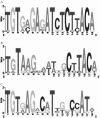Prediction of CsrA-regulating small RNAs in bacteria and their experimental verification in Vibrio fischeri
- PMID: 16822857
- PMCID: PMC1488887
- DOI: 10.1093/nar/gkl439
Prediction of CsrA-regulating small RNAs in bacteria and their experimental verification in Vibrio fischeri
Abstract
The role of small RNAs as critical components of global regulatory networks has been highlighted by several recent studies. An important class of such small RNAs is represented by CsrB and CsrC of Escherichia coli, which control the activity of the global regulator CsrA. Given the critical role played by CsrA in several bacterial species, an important problem is the identification of CsrA-regulating small RNAs. In this paper, we develop a computer program (CSRNA_FIND) designed to locate potential CsrA-regulating small RNAs in bacteria. Using CSRNA_FIND to search the genomes of bacteria having homologs of CsrA, we identify all the experimentally known CsrA-regulating small RNAs and also make predictions for several novel small RNAs. We have verified experimentally our predictions for two CsrA-regulating small RNAs in Vibrio fischeri. As more genomes are sequenced, CSRNA_FIND can be used to locate the corresponding small RNAs that regulate CsrA homologs. This work thus opens up several avenues of research in understanding the mode of CsrA regulation through small RNAs in bacteria.
Figures





Similar articles
-
Regulatory interactions of Csr components: the RNA binding protein CsrA activates csrB transcription in Escherichia coli.J Bacteriol. 2001 Oct;183(20):6017-27. doi: 10.1128/JB.183.20.6017-6027.2001. J Bacteriol. 2001. PMID: 11567002 Free PMC article.
-
Circuitry Linking the Catabolite Repression and Csr Global Regulatory Systems of Escherichia coli.J Bacteriol. 2016 Oct 7;198(21):3000-3015. doi: 10.1128/JB.00454-16. Print 2016 Nov 1. J Bacteriol. 2016. PMID: 27551019 Free PMC article.
-
CsrA interacting small RNAs in Haemophilus spp genomes: a theoretical analysis.Arch Microbiol. 2009 May;191(5):451-9. doi: 10.1007/s00203-009-0474-y. Epub 2009 Apr 7. Arch Microbiol. 2009. PMID: 19350225
-
Global regulation by the small RNA-binding protein CsrA and the non-coding RNA molecule CsrB.Mol Microbiol. 1998 Sep;29(6):1321-30. doi: 10.1046/j.1365-2958.1998.01021.x. Mol Microbiol. 1998. PMID: 9781871 Review.
-
How to find small non-coding RNAs in bacteria.Biol Chem. 2005 Dec;386(12):1219-38. doi: 10.1515/BC.2005.140. Biol Chem. 2005. PMID: 16336117 Review.
Cited by
-
Chromatin Immunoprecipitation Sequencing Technology Reveals Global Regulatory Roles of Low-Cell-Density Quorum-Sensing Regulator AphA in the Pathogen Vibrio alginolyticus.J Bacteriol. 2016 Oct 7;198(21):2985-2999. doi: 10.1128/JB.00520-16. Print 2016 Nov 1. J Bacteriol. 2016. PMID: 27551022 Free PMC article.
-
RNA-binding proteins involved in post-transcriptional regulation in bacteria.Front Microbiol. 2015 Mar 3;6:141. doi: 10.3389/fmicb.2015.00141. eCollection 2015. Front Microbiol. 2015. PMID: 25784899 Free PMC article. Review.
-
A sequence-based approach for prediction of CsrA/RsmA targets in bacteria with experimental validation in Pseudomonas aeruginosa.Nucleic Acids Res. 2014 Jun;42(11):6811-25. doi: 10.1093/nar/gku309. Epub 2014 Apr 29. Nucleic Acids Res. 2014. PMID: 24782516 Free PMC article.
-
Exploring the expression and functionality of the rsm sRNAs in Pseudomonas syringae pv. tomato DC3000.RNA Biol. 2021 Nov;18(11):1818-1833. doi: 10.1080/15476286.2020.1871217. Epub 2021 Feb 23. RNA Biol. 2021. PMID: 33406981 Free PMC article.
-
Transcriptome Sequencing Reveals Wide Expression Reprogramming of Basal and Unknown Genes in Leptospira biflexa Biofilms.mSphere. 2016 Apr 6;1(2):e00042-16. doi: 10.1128/mSphere.00042-16. eCollection 2016 Mar-Apr. mSphere. 2016. PMID: 27303713 Free PMC article.
References
-
- Argaman L., Hershberg R., Vogel J., Bejerano G., Wagner E.G., Margalit H., Altuvia S. Novel small RNA-encoding genes in the intergenic regions of Escherichia coli. Curr. Biol. 2001;11:941–950. - PubMed
-
- Zhang A., Wassarman K.M., Rosenow C., Tjaden B.C., Storz G., Gottesman S. Global analysis of small RNA and mRNA targets of Hfq. Mol. Microbiol. 2003;50:1111–1124. - PubMed
Publication types
MeSH terms
Substances
Grants and funding
LinkOut - more resources
Full Text Sources
Other Literature Sources
Molecular Biology Databases
Research Materials

